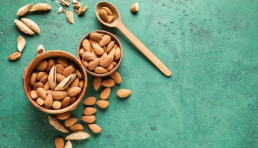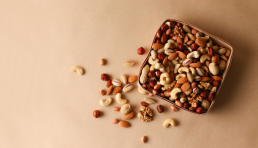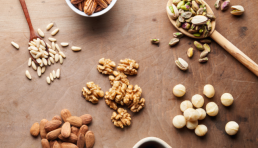Effect of Cashew Nut Consumption on Biomarkers of Copper and Zinc Status in Adolescents with Obesity: A Randomized Controlled Trial
Background: Children and adolescents with obesity have altered serum copper (Cu) and zinc (Zn) levels, which are associated with oxidative stress, inflammation, and health outcomes. The inclusion of cashew nuts in an adequate diet may provide health benefits and help improve the mineral status of individuals with obesity. Objective: To evaluate the effects of cashew nut consumption on biomarkers of Cu and Zn status in adolescents with obesity. Methods: This was a randomized controlled trial conducted in adolescents. The participants were divided into a control group (CON) and a cashew nut group (CASN). The CASN group received 30 g/day of roasted cashew nuts for 12 weeks, and both groups received nutritional counseling during the study. Anthropometric, dietary, and biochemical parameters (Zn, Cu, and superoxide dismutase (SOD)) were assessed at the baseline and at the end of the study. Association tests, within-group and between-group mean comparisons, and analyses of variation between study periods (Δ T12-T0) were performed. Results: The sample consisted of 81 adolescents who completed the intervention period, resulting in 54 in the CASN group and 27 in the CON group. After the intervention, the CASN group presented a decrease in plasma Cu (p = 0.004) and an increase in SOD (p = 0.030). Both groups showed an increase in plasma Zn (p < 0.050) and a decrease in the Cu/Zn ratio (p < 0.001). CASN had a negative effect on the Cu concentration, which was significantly different from that of CON (p = 0.004). Conclusions: The consumption of cashew nuts for 12 weeks reduced plasma Cu levels in adolescents with obesity. Nutritional counseling may have contributed to the increase in plasma Zn levels in all the study participants.
https://doi.org/10.3390/nu17010163
Oil-in-Water Emulsions Made of Pistachio Oil: Physical and Chemical Properties and Stability
Pistachio nuts are valued for their sensory qualities, nutritional benefits, and health-promoting properties. Pistachio oil has also gained interest for its bioactive compounds, though these are sensitive to processing and environmental stresses. While pistachio-based products are commercially available, little research has addressed the emulsifying properties of crude pistachio oil or its impact on the stability and bioactive profile of oil-in-water (O/W) emulsions. This study evaluated the emulsion-forming abilities of two commercial pistachio oils (PO1, PO2), their physical and oxidative stability during emulsification, and the effects of emulsifier concentration over short-term storage (7 days, 4 °C). O/W emulsions were prepared using 20% (w/w) oil and Tween 20 (0.5% and 1% w/w) in phosphate buffer and homogenized under high pressure. The emulsions were analyzed for particle size, fatty acid profile, antioxidants, and oxidative state. The results revealed differences in fatty acid composition, oxidative stability, and bioactive content between the oils and their emulsions. PO1 showed higher levels of bioactives compared to PO2. Emulsification increased the peroxide value of the oil phase, confirming its pro-oxidant effects. The results of this study demonstrate the potential of pistachio oil to create stable O/W emulsions rich in bioactives, offering new opportunities for healthy emulsified food products.
https://doi.org/10.3390/foods14010060
Evaluation of the Phenolic Components, Fiber Content, Antioxidant Activity, and Prebiotic Capacity of a Shortbread Cookie Fortified with Hazelnut Skin Waste
Food reformulation is a strategy to make healthier foods by using food waste matrices that are still nutritionally valid. A shortbread cookie was reformulated replacing hazelnut skin (HS) of the Tonda Gentile Romana variety (5% and 10%) to refined flour and proportionally decreasing the butter amount. This resulted in significant, two- and five-fold, increases in the antioxidant capacity compared with the control, in the 5% and 10% fortified recipes, respectively. Among the most important antioxidants, gallic acid, catechin, phloridzin, and protocatechuic acid were found. Moreover, here we found, for the first time, that HS from the Romana variety had a high total fiber content (44.13 g/100 g), most of which was insoluble fiber. Therefore, HS 10% addition to the shortbread cookie recipe caused a significant increase in fiber content, making the experimental cookie earn the nutritional claim of "high fiber content". Finally, preliminary evidence demonstrated that 10% HS, in comparison to 5%, following in vitro upper gastrointestinal digestion, conferred significant prebiotic activity in an in vitro culture of L. rhamnosus. Therefore, from the perspective of the circular economy, HS could be a valuable ingredient to increase the antioxidant and prebiotic activities of conventional foods.
https://doi.org/10.3390/foods13233814
Reuse of Almond Skin to Formulate a New Gluten- and Lactose-Free Bakery Product
This work aimed to propose the reuse of processing waste from the Sicilian almond (Prunus amygdalus Batsch.) cultivar Tuono for the formulation of a new functional baked product (muffin) that is gluten- and lactose-free. Muffins were prepared using orange juice, rice flour, extra virgin olive oil, and enriched almond skin (3% and 6% w/w). The chemical-physical parameters, total phenols, and flavonoids (TPC and TFC), as well as the biological properties of the ingredients and muffins, were evaluated. Sensory analyses were also conducted. DPPH, ABTS, β-carotene bleaching, and FRAP tests were applied to measure the antioxidant potential. Muffin extracts were also tested against α-amylase and α-glucosidase enzymes. Muffins enriched with 6% almond skin (M6) showed the highest TPC and TFC with values of 26.96 mg gallic acid equivalent (GAE)/g and 24.12 mg quercetin equivalent (QE)/g, respectively. M6 exerted a promising antioxidant activity as an inhibitor of lipid peroxidation, with an IC50 of 15.44 μg/mL at 30 min incubation. Moreover, muffin M6 showed a promising α-glucosidase inhibitory effect (IC50 of 51.82 μg/mL). Based on the obtained results and supported by sensory analysis, muffins enriched with almond skin should be proposed as a promising example of upcycling for the development of a new functional bakery product.
https://doi.org/10.3390/foods13233796
Native cover crops enhance biodiversity and ecosystem services in hazelnut orchards
Agroecological restoration aims to restore biodiversity and ecosystem function in agricultural landscapes while sustaining crop production. Adopting native plants as cover crops may restore ecological value to cropping systems such as nut orchards. We focused on Oregon hazelnut orchards and compared how four seed mixes (native annuals, native perennials, conventional cover crops and unseeded controls) performed under three levels of orchard floor disturbance (flailing, flailing and scraping, and unmanaged/none) across three different orchard ages with corresponding differences in canopy shade over a 2-year period. We evaluated cover crop performance by three criteria: the survival criteria (response to disturbance and shading), the production criteria (effects on weeds, erosion potential and soil moisture) and the ecological functioning criteria (abundance and diversity of native plants and pollinator visitations). We found that native species generally outperformed conventional cover crops and bare ground across these criteria. Plant survival was not affected by disturbance but shading reduced survival of most species. Native annuals had high cover in the first year, and native perennials had high cover across both years. Native perennial species provided the best weed reduction and erosion control while not reducing soil moisture, and hosted the highest pollinator abundances and diversity. Synthesis and applications. Our results suggest that agroecological restoration of orchards through native cover cropping is a viable strategy for improving ecological outcomes without compromising production needs.
https://doi.org/10.1111/1365-2664.14850
INC Statistical Yearbook Now Published – Key Insights Available to Members
We are excited to announce the release of our highly anticipated INC Statistical Yearbook, a comprehensive resource that offers a deep dive into global production trends, leading producers, consumption patterns, and trade dynamics. This yearbook provides essential data and insights that highlight the current state of the global nut and dried fruit sector.
Key Insights from the Statistical Yearbook:
Production Growth: World tree nut production has nearly doubled over the last decade, from 3.62 million metric tons (MT) in 2014/15 to 5.69 M MT in 2023/24 and an estimated 5.97 M MT for 2024/25 (kernel basis, except pistachios in-shell). Following a peak of 50.78 M MT in 2020/21 (in-shell basis), global peanut production amounted to 47.73 M MT in 2023/24 and a recovery to a new high of 52.48 M MT is projected to 2024/25. Total dried fruit production amounted to 3.36 M MT in 2023/24 and is estimated at 3.33 M MT for 2024/25.
Top Producers: The USA leads tree nut production with 39% of the 2023/24 global share; China ranks second with 12%, followed by Türkiye at 10%. China (38%) and India (13%) dominate peanut production; the USA and Türkiye lead dried fruit production with a 12% and 11% of the share, respectively.
Consumption: Almonds (27% of the total share in 2023), cashews (21%), and walnuts (20%) lead tree nut consumption; pistachios accounted for 17%, while hazelnuts made up 10% of the total. Asia leads global tree nut consumption, accounting for 50% of the share. Europe contributes 27%, followed by North America at 19%. Dried grapes and dates dominated dried fruit consumption (38% each), with Asia also leading at 48%, followed by Europe and Northern Africa.
Trade: The USA dominates exports, with almonds clearly leading the country share and walnuts and pistachios as significant contributors. India and Argentina lead in peanuts; Europe and Asia are key import markets for nuts. Türkiye remains a key exporter of dried grapes, apricots, and figs, while the USA leads in cranberries and prunes, with Europe as the top import market.
How to Access the INC Statistical Yearbook
The Statistical Yearbook is now available exclusively to our members. You can access this detailed report in the private area of our website.
If you're not a member yet, we encourage you to join us today. Membership grants access to the Statistical Yearbook along with a wealth of other valuable resources, industry insights, and other key benefits designed to help empower your business globally.
Research Suggests Eating Almonds Regularly May Improve Recovery After Exercise
Two handfuls of almonds daily may help reduce post-exercise pain and muscle damage
A randomized crossover study published recently in Current Developments in Nutrition evaluated the impact of almonds on pain, muscle force production, and biochemical indices of muscle damage and inflammation during recovery from exercise.
In the study, 26 middle-aged adults were instructed to eat either 57 g (two ounces) of whole raw almonds or a calorie-matched serving of unsalted pretzels daily. After eight weeks of eating almonds or pretzels, and with a four-week washout period between the two interventions, participants performed a 30-minute downhill treadmill run to induce muscle damage and then were immediately given their daily serving of almonds or pretzels. Participants continued to eat daily servings of almonds or pretzels for three days after the run. Perceived muscle soreness, muscle performance, and blood markers of muscle damage/inflammation were measured before the run and at 24, 48, and 72 hours after the run.
The almond group had lower levels of creatine kinase (a marker of muscle damage), a quicker decline in creatine kinase levels after 72 hours (suggesting faster recovery), better muscle performance at 24 and 72 hours, and modestly reduced pain ratings following maximal contraction at 24 and 48 hours. The researchers concluded that this apparent effect of almond ingestion on exercise recovery has the potential to help people stick to their exercise routines.
This study was supported by the Almond Board of California.
Rayo, V. U., Cervantes, M., Hong, M. Y., Hooshmand, S., Jason, N., Liu, C., North, E., Okamoto, L., Storm, S., Witard, O. C., & Kern, M. (2024). Almond Consumption Modestly Improves Pain Ratings, Muscle Force Production, and Biochemical Markers of Muscle Damage Following Downhill Running in Mildly Overweight, Middle-Aged Adults: A Randomized, Crossover Trial. Current Developments in Nutrition, 8(9), 104432.
Nut Consumption Associated With Longer Healthy Lifespan
Daily nut intake may be most beneficial for those with sub-optimal diet quality
A prospective cohort study published recently in Age and Ageing set out to determine whether nut consumption was associated with disability-free survival —a measure of healthy lifespan— in adults aged 70 years and older and whether this association varied according to overall diet quality.
The study involved 9,916 participants, of whom 54% were women and 46% were men, with a mean age of 77 years. Frequency of nut intake was determined with a 49-item food frequency questionnaire. Disability-free survival was measured as survival without dementia or major physical disability. The follow-up period was 3.9 years.
The findings showed that the risk of reaching the end of disability-free survival —i.e., onset of dementia, persistent physical disability, or death— was 23% lower for those who consumed nuts daily than for those who rarely or never ate nuts. Subgroup analysis showed a significant association between daily nut consumption and healthy lifespan among individuals in the second diet-quality tertile, suggesting that regular nut intake may be most beneficial for individuals with suboptimal diet quality overall.
Wild, H., Nurgozhina, M., Gasevic, D., Coates, A. M., Woods, R. L., Ryan, J., Beilin, L., Govindaraju, T., McNeil, J. J., & Owen, A. J. (2024). Nut consumption and disability-free survival in community-dwelling older adults: a prospective cohort study. Age and Ageing, 53(11), afae239.
New Study Explores the Potential of Upcycling Nut Byproducts
Study by INC Award winner outlines food, nutraceutical, and pharmaceutical applications
A recent review published in Food Chemistry presents a comprehensive overview of the upcycling of commercial nut byproducts. The first author of the study is Prof. Cesarettin Alasalvar, winner of the 2024 INC Excellence in Research Award.
The article outlines the various ways in which nut byproducts —namely husk/hull, hard shell, brown skin, defatted flour/meal/cake, pine cone, cashew nut shell liquid, cashew apple, walnut septum, and dreg/okara— can be upcycled for food, nutraceutical, and pharmaceutical applications. The authors describe the great potential of these practices to minimize waste and contribute to the circular economy by transforming byproducts into high-value resources. In addition, the article describes the unique functional properties of each byproduct and their potential to promote better health and well-being.
The researchers concluded that the recovery of byproducts and the formulation of novel products presents a valuable opportunity. Additionally, they express hope that their findings could spark interest among consumers and researchers to explore the potential of these underutilized byproducts.
Alasalvar, C., Huang, G., Bolling, B. W., Jantip, P. A., Pegg, R. B., Wong, X. K., Chang, S. K., Pelvan, E., de Camargo, A. C., Mandalari, G., Hossain, A., & Shahidi, F. (2024). Upcycling commercial nut byproducts for food, nutraceutical, and pharmaceutical applications: A comprehensive review. Food Chemistry, 467, 142222. Advance online publication.
Safety of oral immunotherapy for cashew nut and peanut allergy in children - a retrospective single-centre study
Aim of the study: Oral immunotherapy (OIT) is increasingly used for the treatment of childhood food allergies, with limited data available on cashew nut OIT. This real-life study investigated the safety and feasibility of cashew nut OIT, comparing it with peanut OIT, with a focus on the up-dosing process. Methods: We analysed cashew nut (n = 24) and peanut (n = 38) OIT cases with treatment initiated between 2018 and 2022 at the University Children's Hospital Basel. All patients who commenced therapy within this time frame were enrolled without prior selection. Two different starting protocols were used. Within the up-dosing protocol, the nut intake was incrementally increased by 20-30% every 2 weeks until reaching a maintenance dose of 1 g of nut protein. After consuming the maintenance dose regularly for 18-24 months, a second oral food challenge was performed. Patients who passed this challenge were considered desensitised. The safety of the therapy was evaluated based on the severity of adverse reactions during the up-dosing phase. Symptom severity was evaluated using the validated ordinal food allergy severity scale (o-FASS-5). Results: Over the study period, 33% of cashew nut-allergic and 63% of peanut-allergic patients experienced mild to moderate allergic reactions. Severe allergic reactions occurred in five peanut-allergic children with high baseline allergen-specific IgE levels. Six patients with peanut, and none with cashew nut OIT, discontinued the therapy due to adverse reactions. The mean duration to reach the maintenance phase was longer for children with asthma or another food allergy. Among children who already underwent the second oral food challenge, desensitisation was achieved in 91% (11 out of 12) of cashew nut- and 73% (11 out of 15) of peanut-allergic patients. Conclusion: Cashew nut OIT had a low severity of adverse reactions and was generally well-tolerated. However, patient characteristics influenced side effect risk and treatment duration, emphasising the need for individualised OIT strategies.
https://doi.org/10.57187/s.3691



